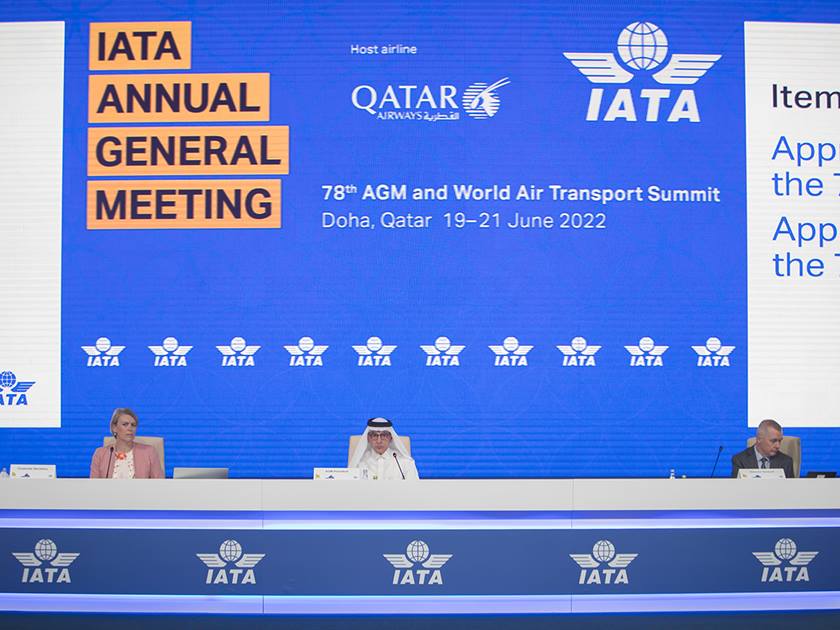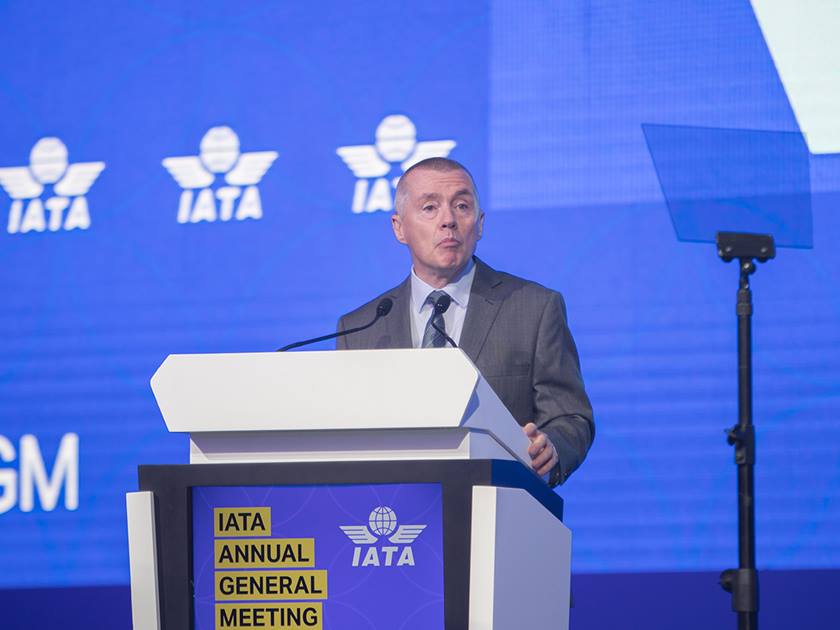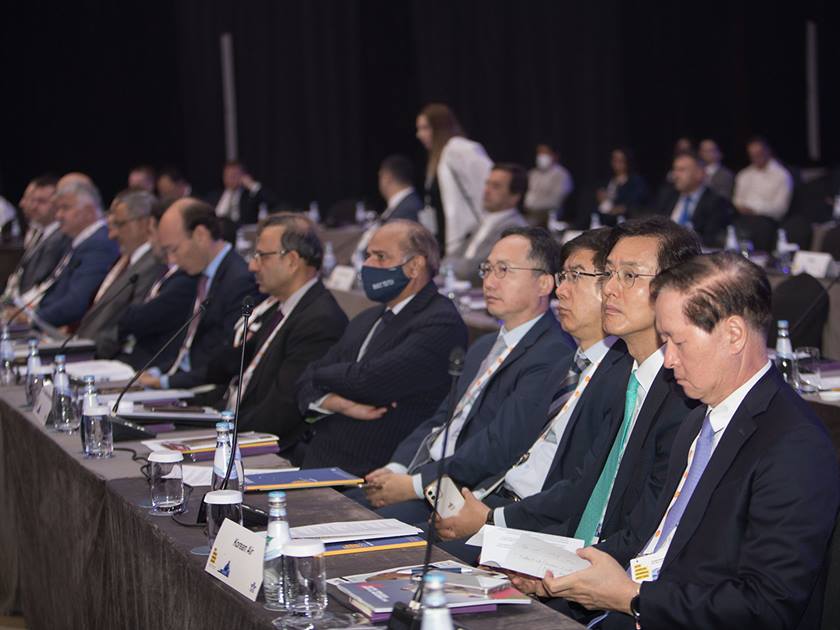Doha, June 20 (QNA) - The 78th edition of IATA's Annual General Meeting and World Air Transport Summit kicked-off today in Doha, with more than 750 guests from the leaders of the aviation sector around the world attending, in addition to more than 150 international media crews. The meetings will deal with the most important topics, issues and global trends related to the aviation sector.
During the opening session, HE Minister of Transport Jassim bin Saif bin Ahmed Al Sulaiti welcomed all the delegations participating in the meetings and the World Air Transport Summit. He commended the strenuous efforts of IATA in uniting global efforts towards a safe and sustainable air transport industry.
For his part, HE Qatar Airways Group Chief Executive, Akbar Al Baker and Chairman of IATA's 78th AGM and World Air Transport Summit said that the meeting is the most prominent event in the aviation sector, and comes at the perfect time as the sector strives to overcome numerous operational and commercial challenges.
He noted that Qatar was the first country in the Middle-East region to sign a comprehensive air transport agreement with the EU five years ago. He added that Qatar will look to work towards reaching open skies.
Airlines Flexibility
Meanwhile Director-General of IATA William M. Walsh underscored the critical importance of the phase the aviation sector is in, indicating that airlines' flexibility enhanced their ability to fulfill the demands associated with the increase in passenger numbers. He noted however that the cargo sector was performing well despite unstable economic conditions around the world. He said that the sector is forecast to record losses of $9.7 billion dollars, lower than last year, and profits in 2023. He added that the sector is now going through a period of optimism despite the challenges related to costs, especially fuel, as well as restrictions that remain in some key markets.
He highlighted that the aviation sector was affected by the pandemic as passenger numbers fell by 60 percent in 2020 and 50 percent in 2021, with airlines losing nearly $200 billion over two years. He added that while some companies in the sector went bankrupt, others managed to return to making profits, thanks mostly to government subsidies. He said that IATA had to move the venue of its AGM this year from Shanghai to Qatar, as China continues to battle with the COVID-19 pandemic.
He stressed the requirement for receiving government support to invest in this sector in a way that helps achieve the aspirations that IATA aspires to, economically and environmentally, stressing that his optimism, because governments would support the industry's ambitions by agreement on an ambitious long-term goal at the upcoming ICAO Assembly. He said that passengers the decarbonization of the industry, and they expect that both the industry and governments will work together to achieve net zero by 2050.
He concluded his statements by confirming that suppliers, including airports and air navigation service providers, should focus on the issue of cost control, as their customers continue to support the recovery of the sector.
The World Air Transport Summit dealt with a number of important themes, including the effects of the war in Ukraine on the aviation sector, the role of this sector in supporting global efforts to reduce emissions harmful to the environment, and also helping airlines address the challenges posed by carbon offsets, and regulatory and financial challenges facing global airlines in general.
The IATA conference called on governments to adopt an ambitious long-term goal of decarbonizing in aviation, as airlines chart a path for the industry to achieve net zero emissions by 2050 in line with the Paris Agreement target of limiting temperature increases 1.5 degrees Celsius above pre-industrial levels. It noted that decarbonizing the global economy will require investments across countries for a number a decades, particularly in the transition away from fossil fuels, noting that the Oct. 2021 IATA AGM meeting saw member airlines make a strong commitment to achieving net zero emissions by 2050. The stressed the importance of government support with policies focusing on achieving net zero emissions. The projected size of the industry in 2050 will require the mitigation of 1.8 gigatons of Carbon, with investments across the value chain amounting to trillions of dollars.
The International Air Transport Association (IATA) also made it clear that air passengers are expected to reach 83 percent of pre-pandemic levels this year and that the airline industry's return to profits could come in 2023. The significant recovery in air travel from its levels during the pandemic will allow global airlines to reduce their losses this year and could see the industry return to making profits in 2023, with the association expecting airlines to incur a loss of $9.7 billion globally in 2022, compared to $42.1 billion dollars in 2021. The forecast for 2022 was about $2 billion better than a previous forecast of a loss of $11.6 billion, and last year’s losses are lower compared to the previous forecast of $52 billion, despite the warnings high oil prices and inflation risks are likely to undermine the fragile recovery.
Future Prospects
A number of officials in the global aviation sector stressed that this year’s annual general assembly represented an important opportunity for the sector's aviation leaders to reflect on the changing political, economic and technological realities facing the industry as it recovers from the pandemic. The meeting will see members work together on building a stronger future for the industry as a whole.
Data from a recent IATA survey showed that improving the environmental impact of airlines is the post-pandemic priority for passengers, with 73 percent of people surveyed wanting the airline industry to focus on reducing their impact on climate when they emerges from the pandemic. Two-thirds of the people surveyed also believed that taxing the industry would not achieve net zero faster, and were concerned about money being raised that was not earmarked for decarbonization projects.
This is the second time that this meeting has taken place in Qatar. The first time was back in 2014. The decision to change the venue was a result of the ongoing restrictions related to travel procedures to China due to the Coronavirus pandemic (COVID-19).
During the General Assembly, IATA announced updating its forecasts for the financial performance of airlines for 2022, coinciding with the acceleration of the sector's recovery from the COVID-19 repercussions.
IATA confirmed that among the most prominent of its expectations is the decrease of the losses in the air transport sector to $9.7 billion compared to the $11.6 billion forecast in October 2021. IATA also said that the industry will be able to achieve greater profits during 2023, and that North America expected to achieve profits of $8.8 billion.
IATA also expects factors such as efficiency gains and improved revenue to help airlines reduce losses even as labor and fuel costs rise. The sector grows optimistic and committed to reducing emissions with the expected delivery of more than 1,200 aircraft in 2022.
The high levels of demand are driven by many factors such as the lifting of travel restrictions in most markets, the low unemployment rates in most countries, and the increase in personal savings. The number of passengers in 2022 is forecast to reach 83 percent of pre-pandemic levels, according to IATA. IATA also expects cargo volumes to reach new records at 68.4 million tons during 2022, despite the economic challenges the world is facing.
The sector’s revenues increased in light of the easing of COVID-19 restrictions and the return of travelers, but the need to control costs remains an important challenges in 2022. The sector’s revenues are expected to reach $782 billion (an increase of 54.5 percent from 2021). That's 93.3 percent of the number recorded in 2019. Total trips in 2022 could reach 33.8 million, representing 86.9 percent of the figures recorded during 2019 according to IATA. The association forecasts passenger revenue at $498 billion, more than double the $239 billion achieved in 2021. Scheduled passenger numbers are also expected to reach 3.8 billion passengers.
IATA also forecast that the cargo revenues will reach $191 billion from the total revenues of the sector, which is slightly lower than the value recorded in 2021, which amounted to $204 billion, doubling what the sector achieved in 2019.
Overall, forecasts indicate that the sector will achieve a new record of more than 68 million tons in shipments in 2022. The cargo revenue is expected to decline by up to 10.4 percent compared to 2021 in light of the slight slowdown in global trade.
In terms of expenditures, IATA expects total expenditures to rise to $796 billion, a 44 percent increase over 2021, reflecting both costs incurred in supporting broader operations and inflation costs in some key items such as fuel, as it is the most expensive cost for the sector during 2022 with a value of 192 billion US dollars. This represents 24 percent of the total costs. Labor constitutes the second-highest operating costs for airlines. Current forecasts indicate that direct labor force has increased to 2.7 million workers, or 4.3 percent year-over-year.
Wages are expected to reach $173 billion in 2022, an increase of 7.9 percent from 2021.
Macroeconomic Landscape
IATA emphasized the great impact of the global macroeconomic landscape to the sector's outlook, as these forecasts include the possibility of strong global GDP growth of 3.4% during 2022. On the other hand, inflation rate has risen and is expected to continue to grow throughout the current year before slowing down gradually in 2023. In conjunction with the rise in nominal interest rates, expectations indicate that real interest rates may remain low or negative for a period of time.
IATA pointed out that the financial performance in all regions is expected to improve during 2022, compared to 2021. Expectations indicate that North America will remain the region with the best performance, as well as the only one to significantly improve its profits during 2022. Net profits in the region may reach $8.8 billion in 2022, thanks to the huge domestic market in the US and the reopening of global markets, including the North Atlantic.
As for Europe, the war in Ukraine will continue to affect travel trends within the European continent and between Europe and the Asia-Pacific region, yet the war is not expected to affect the recovery trajectory of the travel sector, especially as the region approaches profits in 2022, and its net losses are expected to reach $3.9 billion.
Airlines in the Asia Pacific region are still lagging behind the recovery levels in the sector, mainly due to the severe restrictions on travel movement (particularly in China), while the demand for travel is expected to increase rapidly once these restrictions are eased.
Air travel in Latin America rebounded significantly in 2021, driven by domestic markets and relatively light restrictions on travel procedures in many countries.
In the Middle East, the reopening of international flights, especially long-haul flights, is a positive sign for many this year, and the net losses of the sector across the region are expected to drop to $1.9 billion in 2022 compared to losses of $4.7 billion in 2021 .
The low vaccination rates in Africa has slowed the recovery of the air travel sector so far, but the sector is likely to continue its recovery this year, which will eventually contribute to improving the industry's performance. Net losses are expected to reach $0.7 billion in 2022. (QNA)





